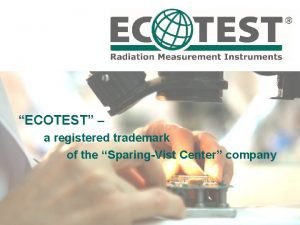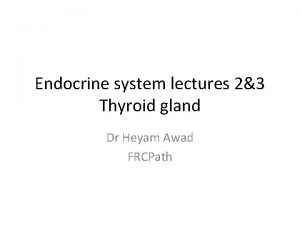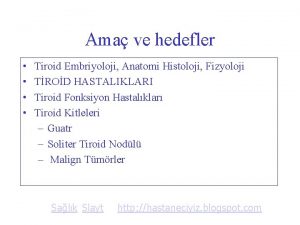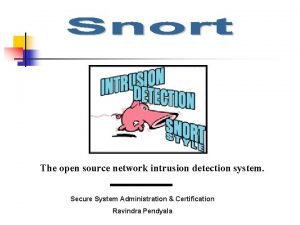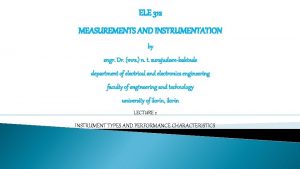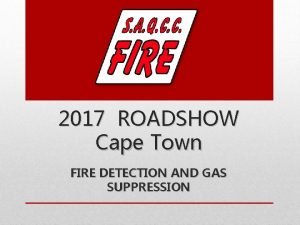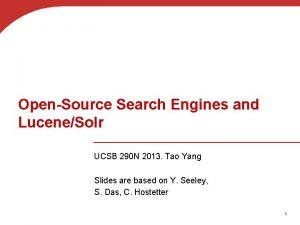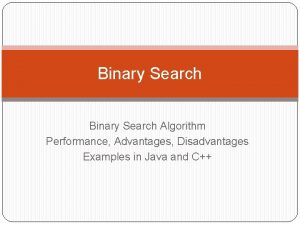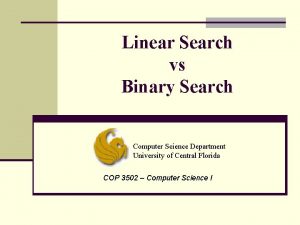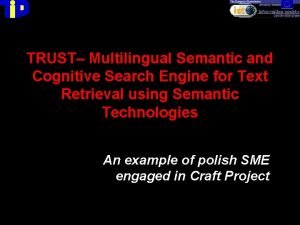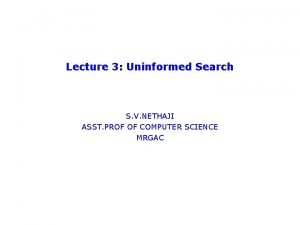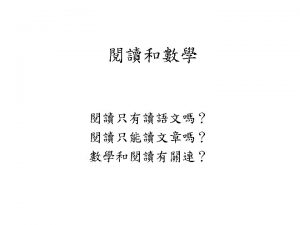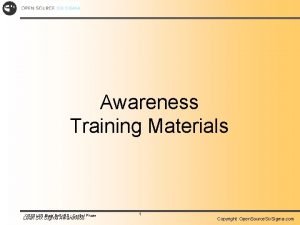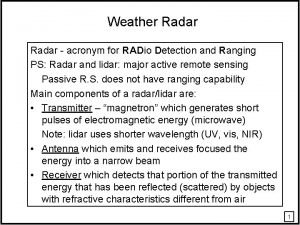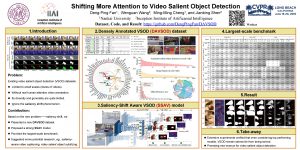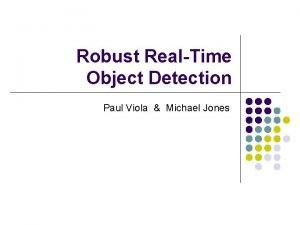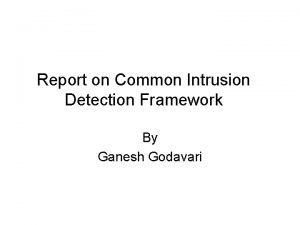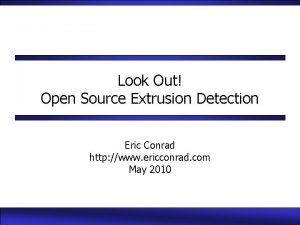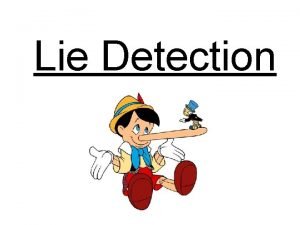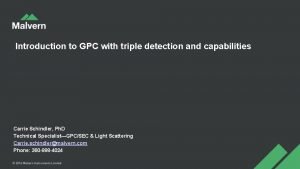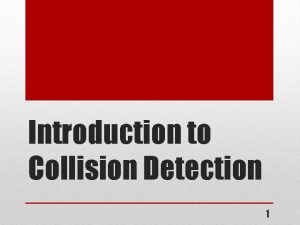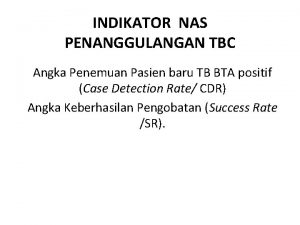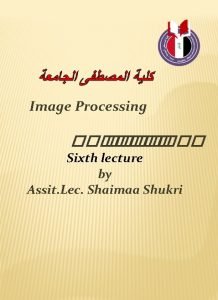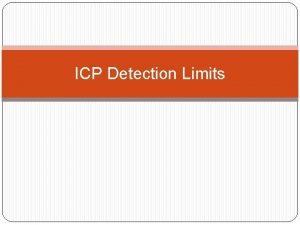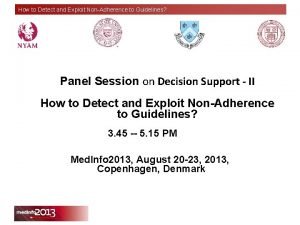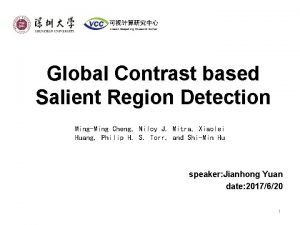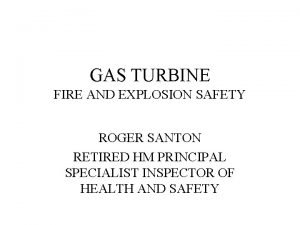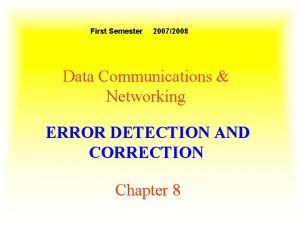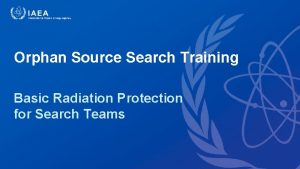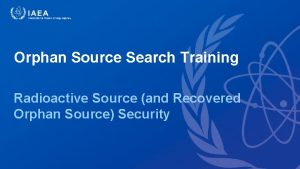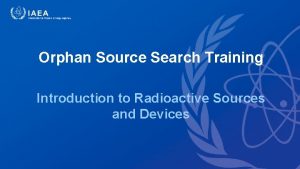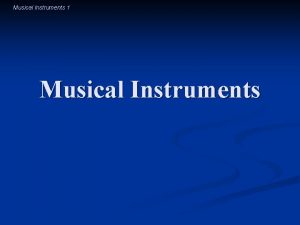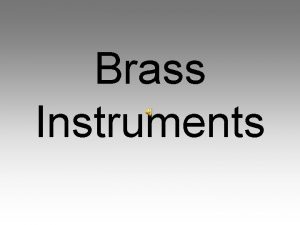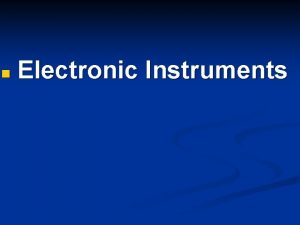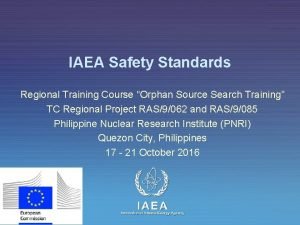Orphan Source Search Training Radiation Detection Instruments Overview
































































- Slides: 64

Orphan Source Search Training Radiation Detection Instruments Overview

Introduction • The purpose of this presentation is to familiarize participants with the broad categories of radiation detection instruments that may be needed to search for an orphan source. • Examples of instruments in each category will be provided Radiation Detection Instruments Overview 2

Overview • Scope of this module • Relevant types of radiological instruments for physical searches for orphan sources – – – Equipment for Searching (surveying) Equipment for measuring Dose Rate Equipment for measuring neutron radiation Equipment for radioisotope identification Equipment for measuring contamination Radiation Detection Instruments Overview 3

Scope • There is a large range and variety of radiological instruments • Instruments are tools • Use the right tool for each task • This module only discusses those instruments relevant to the tasks associated with finding orphan sources and dealing with those found Radiation Detection Instruments Overview 4

Scope • Searching for nuclear material generally requires specialized instruments and is outside the scope of this course • Specific training is needed for the instruments to be used in practice • …or you could be hurt Radiation Detection Instruments Overview 5

Types of Instruments Needed • Searching for sources – Broad area or small, defined area • Measuring dose rates near sources – Normal and high dose rates – Mostly gamma radiation, but neutron too • Identifying the radionuclide of the source • Checking for contamination Radiation Detection Instruments Overview 6

Types of Instruments Needed Radiation Detection Instruments Overview 7

Equipment Sensitivity Radiation Detection Instruments Overview 8

Equipment Categories and Applications Radiation Instrument Alpha Beta Gamma Applications Neutron Search Localization Identification CM DR Pack. Eye Inspector 1000 RG 2000 SG-2 R Rad. Eye Micro. Sievert Radiagem 2000 SAB-100 SABG-15 TELE-STTC Ion Chamber CM - Contamination Measurements, DR - Dose Rate Measurements Radiation Detection Instruments Overview 9

Overview • Scope of this module • Relevant types of radiological instruments for physical searches for orphan sources – – – Equipment for Searching (surveying) Equipment for measuring Dose Rate Equipment for measuring neutron radiation Equipment for radioisotope identification Equipment for measuring contamination Radiation Detection Instruments Overview 10

Search Instruments • Search instruments are used to find or to specifically locate the source – Need to be highly sensitive – Hence usually have large detectors and may be large instruments – Provides the capability to cover large areas quickly – May provide count rate or alarm only – May not provide dose rate – Sodium iodide crystal based detectors are often used because of their high sensitivity Radiation Detection Instruments Overview 11

Search Instruments Broad Area Searches • Broad area search: – (i. e. villages, large complex of buildings, large ships), need aerial, vehicle or backpack systems Radiation Detection Instruments Overview 12

Search Instruments Backpack Instruments • Can be used while driving slowly or walking around Radiation Detection Instruments Overview 13

Search Instruments Backpack Instruments Radiation Detection Instruments Overview 14

Search Instruments Pack. Eye • Large plastic scintillator and two 3 He tubes • Very sensitive to neutron and gamma radiation • Most sensitive piece of equipment in the suite Radiation Detection Instruments Overview 15

Search Instruments Small, Defined Area Searches • Can use sensitive, hand-held instruments • Best for a small, defined area such as a single building Radiation Detection Instruments Overview 16

Search Instruments Choose instruments to characterize the dose rates, identify the radionuclide, and to determine if contamination is present Radiation Detection Instruments Overview 17

Search Instruments When something is found, STOP and make a PLAN Radiation Detection Instruments Overview 18

Search Instruments Examples Radiation Detection Instruments Overview 19

Search Instruments, Examples Radiagem 2000 with SG-2 R Probe • 5 cm x 5 cm (2" x 2") Na. I for high gamma sensitivity • Counts per second (CPS) or Sv h-1 display • High energy button: when depressed, count rate is displayed only above preset threshold • 10 alarm setpoints for each unit stored in probe Radiation Detection Instruments Overview 20

Search Instruments, Examples In. Spector 1000 • 5 cm x 5 cm (2" x 2") Na. I • • • detector Internal GM tube Dose rate range is 10 n. Sv h -1 – 100 m. Sv h-1 Dose range is 0. 01µSv – 10 Sv Only detector capable of nuclide identification Spectrum analysis Radiation Detection Instruments Overview 21

Search Instruments, Examples In. Spector 1000 with Neutron Probe • Moderated 3 He tube • Intrinsic neutron sensitivity ≈1% • Unmoderated 252 Cf • Neutron count rate in CPS Radiation Detection Instruments Overview 22

Search Instruments, Examples • • • Rad. Eye PRD Na. I detector Dose rate range of 0. 01 μSv/h – 250 μSv/h True dose rate calculation Automatic background update (no user action) Natural background rejection (NBR) Use in CPS mode for local area searches Radiation Detection Instruments Overview 23

Search Instruments Examples NOVELEC DG 5 A/P Portable Gamma Detector • DG 5 is aimed to search and/or localize gamma isotope sources. It measures and warns on any significant increase of ambient radioactivity, comparing the measurement to a memory stored reference value. • Detector: An organic scintillator coupled with a photomultiplier Radiation Detection Instruments Overview 24

Search Instruments Examples Radiation Detection Instruments Overview 25

Search Instruments Examples Radiation Detection Instruments Overview 26

Search Instruments Examples Radiation Detection Instruments Overview 27

Search Instruments Examples Finder mode (survey) Detectors: • Gamma: Cd. Zn. Te • Neutrons: 3 He Proportional counter tube Radiation Detection Instruments Overview 28

Search Instruments Examples • PM 1703 MO-1 is equipped with two detection modules: • highly sensitive Cs. I(Tl) scintillation detector (to search radioactive and nuclear materials), • small-sized GM tube detector (to measure dose rate of gamma radiation) Radiation Detection Instruments Overview 29

Overview • Scope of this module • Relevant types of radiological instruments for physical searches for orphan sources • Equipment for Searching (surveying) – – Equipment for measuring Dose Rate Equipment for measuring neutron radiation Equipment for radioisotope identification Equipment for measuring contamination Radiation Detection Instruments Overview 30

Dose Rate Instruments • Used for radiation safety purposes: – To characterize dose rates to personnel – To ensure that the dose rate is not hazardous in the search area – To develop stay times in areas with elevated dose rates • Also used to characterize the found source and help determine its activity • Not as sensitive as search instruments • So should not be used to search for sources Radiation Detection Instruments Overview 31

Dose Rate Instruments Ionization Chambers • Are good dose rate instruments in the range of interest • Can be more delicate • Not for search Radiation Detection Instruments Overview 32

Dose Rate Instruments, Examples • • • Dose rate range of 2 μSv/h – 500 m. Sv/h Air-filled ionization chamber 40 ke. V – 1. 3 Me. V Beta + Gamma measurements (open window) Stand-alone unit Best used for accurate gamma measurements – Estimation of activity – Dose rates Ion Chamber 9 -4 Radiation Detection Instruments Overview 33

Dose Rate Instruments • Enable high radiation fields near unshielded sources to be assessed from a safe distance Long-handled Instruments Radiation Detection Instruments Overview 34

Dose Rate Instruments, Examples Radiation Detection Instruments Overview 35

Dose Rate Instruments, Examples • Used with Radiagem 2000 ratemeter • Dose rate range is 0. 3 µSv / h-10 Sv/h • Energy compensated GM • Variable length 1. 1 - 3. 3 meters • Best used for: • Localizing high activity sources • Estimating activity TELE-STTC Telescoping Probe Radiation Detection Instruments Overview 36

Dose Rate Instruments, examples Radiation Detection Instruments Overview 37

Dose Rate Instruments, examples Radiation Detection Instruments Overview 38

Dose Rate Instruments, examples Radiation Detection Instruments Overview 39

Dose Rate Instruments, examples Radiation Detection Instruments Overview 40

Dose Rate Instruments, Examples • • • Dose rate range of 0. 01 – 5 µSv/h 2. 5 cm x 2. 5 cm (1" x 1") Na. I detector 50 ke. V – 1. 3 Me. V (Gamma and x-ray) Stand-alone unit (no external probes) Best used for low-level gamma radiation Model 19 A Radiation Detection Instruments Overview 41

Dose Rate Instruments, Examples • • • Dose rate range of 0. 01 – 2000 µSv/h Internal Tissue-Equivalent Organic Scintillator 40 ke. V – 1. 3 Me. V (Gamma and xray) Stand-alone unit (no external probes) Best Used for: low level gamma fields Micro. Sievert Meter Radiation Detection Instruments Overview 42

Overview • Scope of this module • Relevant types of radiological instruments for physical searches for orphan sources • Equipment for Searching (surveying) • Equipment for measuring Dose Rate – Equipment for measuring neutron radiation – Equipment for radioisotope identification – Equipment for measuring contamination Radiation Detection Instruments Overview 43

Neutron Instruments • Needed if neutron sources (e. g. Cf-252, Am. Be, Pu. Be, Ra. Be) are involved • Not very sensitive • Usually heavy, but smaller He-3 detectors now used • Combined instruments available Radiation Detection Instruments Overview 44

Neutron Instruments, examples Radiation Detection Instruments Overview 45

Overview • Scope of this module • Relevant types of radiological instruments for physical searches for orphan sources • Equipment for Searching (surveying) • Equipment for measuring Dose Rate • Equipment for measuring neutron radiation – Equipment for radioisotope identification – Equipment for measuring contamination Radiation Detection Instruments Overview 46

Radioisotope Identifiers • Used to identify or verify the radionuclide of the found source • May or may not provide dose rate • Can record gamma spectrum • May be sensitive enough to use for searching • Beware of possible mis-identification because of internal library or shielding Radiation Detection Instruments Overview 47

Radioisotope Identifiers, examples Radiation Detection Instruments Overview 48

Radioisotope Identifiers, examples Radiation Detection Instruments Overview 49

Radioisotope Identifiers, examples Radiation Detection Instruments Overview 50

Radioisotope Identifiers, examples Radiation Detection Instruments Overview 51

Radioisotope Identifiers, examples Identification mode Radiation Detection Instruments Overview 52

Radioisotope Identifiers Example of a Co-60 Gamma Spectrum Sodium-Iodine Detector Radiation Detection Instruments Overview 53

Overview • Scope of this module • Relevant types of radiological instruments for physical searches for orphan sources • • Equipment for Searching (surveying) Equipment for measuring Dose Rate Equipment for measuring neutron radiation Equipment for radioisotope identification – Equipment for measuring contamination Radiation Detection Instruments Overview 54

Contamination Detectors • Provide indication of the presence of contamination • Some detect beta/gamma only, some alpha only, others do both • Used to survey personnel, objects or surfaces • Should be used in combination with swipes if background count rate is too high to measure removable contamination Radiation Detection Instruments Overview 55

Contamination Detectors, Probes • Typically probes used with count rate meters • Beta/gamma best with pancake GM • Alpha best with scintillator Radiation Detection Instruments Overview 56

Contamination Detectors, examples Radiation Detection Instruments Overview 57

Contamination Detectors, examples • Used with Radiagem 2000 ratemeter • 15 cm 2 pancake probe • Selectable units: • Counts per second (c/s) • Becquerel (Bq) • Becquerel per cm 2 (Bq/cm 2) Alpha / Beta / Gamma Contamination SABG-15+ Radiation Detection Instruments Overview 58

Contamination Detectors, examples • Used with Radiagem 2000 ratemeter • 100 cm 2 thin plastic with Zn. S(Ag) layer • Selectable units: • Counts per second (c/s) • Becquerel (Bq) • Becquerel per cm 2 (Bq/cm 2) Alpha/Beta Contamination Probe SAB-100 Radiation Detection Instruments Overview 59

Contamination Detectors • High sensitivity, 0. 25 mm thick plastic scintillator coated with zinc sulfide (Zn. S) and covered with 0. 4 mg/cm 2 Mylar® Portable Wipe Counter • Detects alpha and beta/gamma radiation with simultaneous discrimination • Range is 0 – 500 k CPM Radiation Detection Instruments Overview 60

Contamination Detectors, examples Radiation Detection Instruments Overview 61

Contamination Detectors, examples Radiation Detection Instruments Overview 62

Summary • Selecting the correct instrument for: – – performing the search, verifying exposure rates, identifying the radionuclide and conducting contamination surveys !! ! • and learning how to use each instrument, • is very important for ensuring the safety of personnel and the accurate evaluation of any found sources Radiation Detection Instruments Overview 63

Thank you!
 Eco test gamma sapien
Eco test gamma sapien The orphan boy and elk dog
The orphan boy and elk dog Intro to typography
Intro to typography Orphan annie eye nuclei
Orphan annie eye nuclei Orphan train museum kansas
Orphan train museum kansas Orphan products grants program
Orphan products grants program Warm up movie
Warm up movie There is a languid emerald sea meaning
There is a languid emerald sea meaning Open orphan investor relations
Open orphan investor relations Orphan gpcr
Orphan gpcr Orphan annie hücreleri
Orphan annie hücreleri Nids open source
Nids open source A passive instrument is
A passive instrument is Indicating instruments and instruments with a signal output
Indicating instruments and instruments with a signal output Saqcc fire detection training
Saqcc fire detection training Open source search engines
Open source search engines Uninformed search methods
Uninformed search methods Unified search vs federated search
Unified search vs federated search èinterest
èinterest Federated search vs distributed search
Federated search vs distributed search Informed and uninformed search in artificial intelligence
Informed and uninformed search in artificial intelligence Images.search.yahoo.com
Images.search.yahoo.com Best first search in ai
Best first search in ai Blind search adalah
Blind search adalah Video.search.yahoo.com search video
Video.search.yahoo.com search video Yahoo search video
Yahoo search video What are the advantages and disadvantages of binary search
What are the advantages and disadvantages of binary search Search by image
Search by image Image search yahoo
Image search yahoo Cognitive search engine
Cognitive search engine Which search strategy is called as blind search
Which search strategy is called as blind search Yahoo
Yahoo Open source six sigma training material
Open source six sigma training material Objectives of search and rescue team
Objectives of search and rescue team Training is expensive without training it is more expensive
Training is expensive without training it is more expensive Perbedaan on the job training dan off the job training
Perbedaan on the job training dan off the job training Aggression replacement training facilitator training
Aggression replacement training facilitator training Acronym for radar
Acronym for radar Detection bias example
Detection bias example Alu to support the mips instruction should have ?
Alu to support the mips instruction should have ? Detection risk formula
Detection risk formula Java deadlock detection
Java deadlock detection Shifting more attention to video salient object detection
Shifting more attention to video salient object detection Perceptual expectancy
Perceptual expectancy Transduction psychology
Transduction psychology Signal detection theory example
Signal detection theory example Speed detection of moving vehicle using speed cameras
Speed detection of moving vehicle using speed cameras Paul viola and michael jones
Paul viola and michael jones Common intrusion detection framework
Common intrusion detection framework Golden ticket detection
Golden ticket detection Recent developments in object detection
Recent developments in object detection Signal detection theory example
Signal detection theory example Hash detector
Hash detector Muscles of facial expression ppt
Muscles of facial expression ppt Extrusion detection
Extrusion detection History of lie detection
History of lie detection Gpc triple detection
Gpc triple detection Collision detection discrete vs continuous
Collision detection discrete vs continuous Rumus case detection rate
Rumus case detection rate Edge detection sobel
Edge detection sobel Limit sample
Limit sample Policy non-compliance: exploit detection
Policy non-compliance: exploit detection Global contrast based salient region detection
Global contrast based salient region detection Fire detection gas turbines
Fire detection gas turbines Error detection methods
Error detection methods
